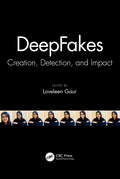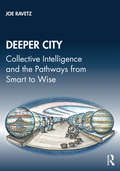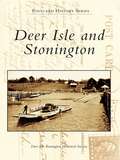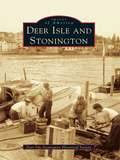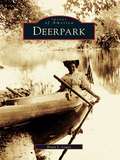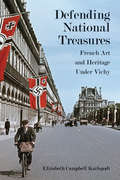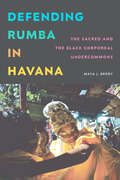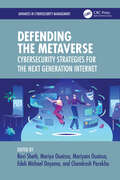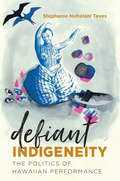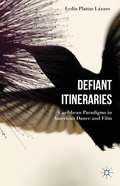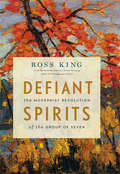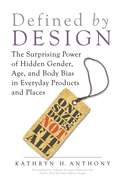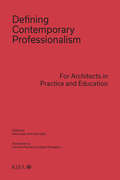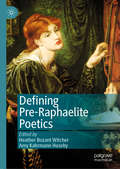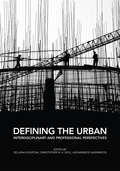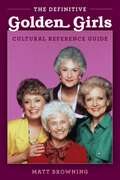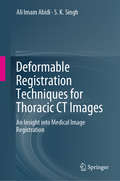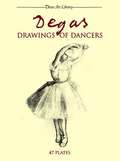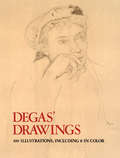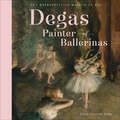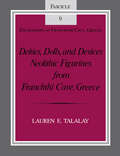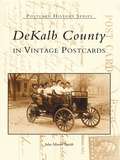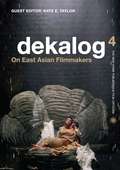- Table View
- List View
DeepFakes: Creation, Detection, and Impact
by Loveleen GaurDeepfakes is a synthetic media that leverage powerful Artificial Intelligence (AI) and machine learning (ML) techniques to generate fake visual and audio content that are extremely realistic, thus making it very hard for a human to distinguish from the original ones. Apart from technological introduction to the Deepfakes concept, the book details algorithms to detect Deepfakes, techniques for identifying manipulated content and identifying face swap, generative adversarial neural networks, media forensic techniques, deep learning architectures, forensic analysis of DeepFakes and so forth. Provides a technical introduction to DeepFakes, its benefits, and the potential harms Presents practical approaches of creation and detection of DeepFakes using Deep Learning (DL) Techniques Draws attention towards various challenging issues and societal impact of DeepFakes with their existing solutions Includes research analysis in the domain of DL fakes for assisting the creation and detection of DeepFakes applications Discusses future research directions with emergence of DeepFakes technology This book is aimed at graduate students, researchers and professionals in data science, artificial intelligence, computer vision, and machine learning.
Deeper City: Collective Intelligence and the Pathways from Smart to Wise
by Joe RavetzDeeper City is the first major application of new thinking on ‘deeper complexity’, applied to grand challenges such as runaway urbanization, climate change and rising inequality. The author provides a new framework for the collective intelligence – the capacity for learning and synergy – in many-layered cities, technologies, economies, ecologies and political systems. The key is in synergistic mapping and design, which can move beyond smart ‘winner-takes-all’ competition, towards wiser human systems of cooperation where ‘winners-are-all’. Forty distinct pathways ‘from smart to wise’ are mapped in Deeper City and presented for strategic action, ranging from local neighbourhoods to global finance. As an atlas of the future, and resource library of pathway mappings, this book expands on the author’s previous work, City-Region 2020. From a decade of development and testing, Deeper City combines visual thinking with a narrative style and practical guidance. This book will be indispensable for those seeking a sustainable future – students, politicians, planners, systems designers, activists, engineers and researchers. A new postscript looks at how these methods can work with respect to the 2020 pandemic, and asks, ‘How can we turn crisis towards transformation?'
Deer Isle and Stonington
by Deer Isle-Stonington Historical SocietyThe island communities of Deer Isle and Stonington lie in Penobscot Bay, a region known and loved by sailors the world over. Deer Isle and Stonington portrays life on the island from the age of ferries and steamships, to the building of the Deer Isle-Sedgwick Bridge, through World War II. These vintage photographs allow the reader to watch as the island's main streets grow and change. Represented are landmarks such as the Mark and Pumpkin Island lighthouses, the Stonington Opera House, and the oldest buildings on the island. The vital industries of seafaring, sail making, commercial fishing, granite quarrying, and yachting are pictured here alongside images of everyday life-celebrations and ceremonies, shopping and picnics, education and worship, work and play.
Deer Isle and Stonington (Images of America)
by Deer Isle-Stonington Historical SocietyThe island communities of Deer Isle and Stonington lie in Penobscot Bay, a region known and loved by sailors the world over. Deer Isle and Stonington portrays life on the island from the age of ferries and steamships, to the building of the Deer Isle-Sedgwick Bridge, through World War II. These vintage photographs allow the reader to watch as the island's main streets grow and change. Represented are landmarks such as the Mark and Pumpkin Island lighthouses, the Stonington Opera House, and the oldest buildings on the island. The vital industries of seafaring, sail making, commercial fishing, granite quarrying, and yachting are pictured here alongside images of everyday life-celebrations and ceremonies, shopping and picnics, education and worship, work and play.
Deerpark (Images of America)
by Brian J. LewisBounded by three rivers and a mountain range, the town of Deerpark lies in the southwestern corner of Orange County. Once the frontier of America, the area took its name from what early settlers called their neighbor's fenced tract: McDaniel's Deer Park. The town has seven hamlets-Cahoonzie, Cuddebackville, Godeffroy, Huguenot, Rio, Sparrowbush, and Westbrookville-shaped and identified by their geography.Deerpark highlights a community that has what is believed to be the oldest one-hundred-mile road in the country, the Old Mine Road. Appearing in this pictorial history are the Delaware and Hudson Canal, which transformed the town, and the railroad, which spawned a thriving resort industry. Also shown are filmmaker D.W. Griffith, who between 1909 and 1911 made silent movies using the mountains and rivers as a backdrop, and many ancestors of present-day residents.
Defend your house from the risk of flooding - Do it yourself: your own bulkhead against flooding
by Silvia Dalla Zanna Pasquale PizzichettiSome say that the danger posed by water is worse than that of fire. In effect I fear both. However, either if you live in a city or in a provincial town, there is always a risk, higher or lower, to be flooded by water. For those who do not want to suffer passively the events, here is a practical guide to build "Do it yourself" bulkheads against flooding. With some good will and time, you can build a low cost efficient system with simple materials. This guide is intended for everybody, but in particular for people who are not professional in this field.
Defending Descartes in Brandenburg-Prussia: The University of Frankfurt an der Oder in the Seventeenth Century (Archimedes #62)
by Pietro Daniel OmodeoThis volume is a study of the many dimensions of the early reception of Cartesianism in German-speaking Europe during the seventeenth century based on the case of the University of Frankfurt an der Oder. It investigates the broad context of that discussion, which was at once scientific, cultural, political and socio-institutional. Chapter by chapter, the book sheds light on the most relevant aspects of the environment of the time. It is aimed at historians of science and philosophy, as well as scholars investigating German-speaking Europe of the 17th century.
Defending National Treasures
by Elizabeth Campbell KarlsgodtDefending National Treasuresexplores the fate of art and cultural heritage during the Nazi occupation of France. The French cultural patrimony was a crucial locus of power struggles between German and French leaders and among influential figures in each country. Karlsgodt examines the preservation policy that the Vichy regime enacted in an assertion of sovereignty over French art museums, historic monuments, and archeological sites. The limits to this sovereignty are apparent from German appropriations of public statues, Jewish-owned art collections, and key "Germanic" works of art from French museums. A final chapter traces the lasting impact of the French wartime reforms on preservation policy. InDefending National Treasures, Karlsgodt introduces the concept ofpatrimaniato reveal examples of opportunism in art preservation. During the war, French officials sought to acquire coveted artwork from Jewish collections for the Louvre and other museums; in the early postwar years, they established a complicated guardianship over unclaimed art recovered from Germany. A cautionary tale for our own times,Defending National Treasuresexamines the ethical dimensions of museum acquisitions in the ongoing noble quest to preserve great works of art.
Defending Rumba in Havana: The Sacred and the Black Corporeal Undercommons
by Maya J. BerryIn Defending Rumba in Havana, anthropologist and dancer Maya J. Berry examines rumba as a way of knowing the embodied and spiritual dimensions of Black political imagination in post-Fidel Cuba. Historically a Black working-class popular dance, rumba, Berry contends, is a method of Black Cuban struggle that provides the community, accountability, sustenance, and dignity that neither the state nor the expanding private market can. Berry’s feminist theorization builds on the notion of the undercommons to show how rumba creates a space in which its practitioners enact deeply felt and dedicatedly defended choreographies of reciprocity, refusal, sovereignty, devotion, and pleasure, both on stage and in their daily lives. Berry demonstrates that this Black corporeal undercommons emphasizes mutual aid and refuses neoliberal development logics, favoring instead a collective self-determination rooted in African diasporic spiritual practices through which material compensation and gendered power dynamics are negotiated. By centering rumba to analyze how poor Black Cubans navigate gendered and racialized life, Berry helps readers better understand the constraints and yearnings that move diasporic Black struggles to seek refuge beyond the bounds of the nation-state.Duke University Press Scholars of Color First Book Award
Defending the Metaverse: Cybersecurity Strategies for the Next Generation Internet (Advances in Cybersecurity Management)
by Ravi ShethThis book is aimed at a diverse audience including students, researchers, academicians, cybersecurity professionals, IT managers, Metaverse developers, business leaders, policymakers, and tech enthusiasts. This book is for everyone—from beginners to experts, researchers, and students. It offers insights and tools suitable for people with different levels of knowledge, making it accessible to a wide range of readers. The book fits alongside other published books by addressing the rapidly evolving intersection of cybersecurity and the Metaverse, a niche yet increasingly critical area.Unlike traditional cybersecurity books that focus on current internet and IT infrastructures, this book uniquely targets the virtual environments of the Metaverse. It combines advanced technological insights with practical strategies, providing a specialized resource that bridges the gap between conventional cybersecurity literature and the futuristic needs of Metaverse security. This positions it as an essential read for those looking to stay ahead in the field of cybersecurity within the context of next-generation internet platforms.
Defiant Indigeneity: The Politics of Hawaiian Performance (Critical Indigeneities)
by Stephanie Nohelani Teves"Aloha" is at once the most significant and the most misunderstood word in the Indigenous Hawaiian lexicon. For K&257;naka Maoli people, the concept of "aloha" is a representation and articulation of their identity, despite its misappropriation and commandeering by non-Native audiences in the form of things like the "hula girl" of popular culture. Considering the way aloha is embodied, performed, and interpreted in Native Hawaiian literature, music, plays, dance, drag performance, and even ghost tours from the twentieth century to the present, Stephanie Nohelani Teves shows that misunderstanding of the concept by non-Native audiences has not prevented the K&257;naka Maoli from using it to create and empower community and articulate its distinct Indigenous meaning.While Native Hawaiian artists, activists, scholars, and other performers have labored to educate diverse publics about the complexity of Indigenous Hawaiian identity, ongoing acts of violence against Indigenous communities have undermined these efforts. In this multidisciplinary work, Teves argues that Indigenous peoples must continue to embrace the performance of their identities in the face of this violence in order to challenge settler-colonialism and its efforts to contain and commodify Hawaiian Indigeneity.
Defiant Itineraries: Caribbean Paradigms in American Dance and Film
by Lydia Platón LázaroHow did Caribbean rituals helped form new currents in the performing and visual arts of the United States? This book answers this question through an examination of the Caribbean-inspired dance creations of dancer/choreographer Katherine Dunham and the experimental films of avant-garde filmmaker Maya Deren.
Defiant Spirits
by Ross KingBeginning in 1912, Defiant Spirits traces the artistic development of Tom Thomson and the future members of the Group of Seven, Franklin Carmichael, Lawren Harris, A. Y. Jackson, Franz Johnston, Arthur Lismer, J. E. H. MacDonald, and Frederick Varley, over a dozen years in Canadian history. Working in an eclectic and sometimes controversial blend of modernist styles, they produced what an English critic celebrated in the 1920s as the "most vital group of paintings" of the 20th century. Inspired by Cézanne, Van Gogh and other modernist artists, they tried to interpret the Ontario landscape in light of the strategies of the international avant-garde. Based after 1914 in the purpose-built Studio Building for Canadian Art, the young artists embarked on what Lawren Harris called "an all-engrossing adventure": travelling north into the anadian Shield and forging a style of painting appropriate to what they regarded as the unique features of Canada's northern landscape.Rigorously researched and drawn from archival documents and letters, Defiant Spirits constitutes a "group biography," reconstructing the men's aspirations, frustrations and achievements. It details not only the lives of Tom Thomson and the members of the Group of Seven but also the political and social history of Canada
Defined by Design: The Surprising Power of Hidden Gender, Age, and Body Bias in Everyday Products and Places
by Kathryn H. AnthonyThis wide-ranging overview of design in everyday life demonstrates how design shapes our lives in ways most of us would never imagine. The author, a leading expert in social and psychological issues in design, uncovers the gender, age, and body biases inherent in the designs of common products and living spaces that we all routinely use. From the schools our children attend and the buildings we work in to ill-fitting clothes and one-size-fits-all seating in public transportation, restaurants, and movie theaters, we are surrounded by an artificial environment that can affect our comfort, our self-image, and even our health.Anthony points out the flaws and disadvantages of certain fashions, children's toys, high-tech gadgets, packaging, public transportation, public restrooms, neighborhood layouts, classrooms, workplaces, hospitals, and more. In an increasingly diverse populace where many body types, age groups, and cultures interact, she argues that it's time our environments caught up. This fascinating book--full of aha moments--will teach readers to recognize the hidden biases in certain products and places and to work for more intelligent and healthy design in all areas of life.
Defining Contemporary Professionalism (missing jacket): For Architects in Practice and Education
by Alan Jones Lorraine Farrelly Rob Hyde Singe KongebroThis book is a series of curated essays by high-profile architecture and design leaders and educators on the topic of professionalism. The book first sets out the current agenda - defining professionalism for the architecture sector - before moving on to focus on delivering the increased professional skills curriculum content within architecture schools as set by the RIBA. With an introduction and conclusion by the Editors, this book explores what contemporary professionalism within architecture is, and its future, encouraging the current and future profession to address professionalism across the industry.
Defining Pre-Raphaelite Poetics
by Heather Bozant Witcher Amy Kahrmann HusebyDefining Pre-Raphaelite Poetics offers a range of Pre-Raphaelite literary scholarship, provoking innovative discussions into the poetic form, gender dynamics, political engagement, and networked communities of Pre-Raphaelitism. The authors in this collection position Pre-Raphaelite poetics broadly in the sense of poiesis, or acts of making, aiming to identify and explore the Pre-Raphaelites’ diverse forms of making: social, aesthetic, gendered, and sacred. Each chapter examines how Pre-Raphaelitism takes up and explores modes of making and re-making identity, relationality, moral transformations, and even, time and space. Essays explore themes of formalist or prosodic approaches, expanded networks of literary and artistic influence within Pre-Raphaelitism, and critical legacies and responses to Pre-Raphaelite poetry and arts, codifying the methods, forms, and commonalties that constitute literary Pre-Raphaelitism.
Defining the Urban: Interdisciplinary and Professional Perspectives
by Alexandros Gasparatos Deljana Iossifova Christopher N.H DollWhat is "urban"? How can it be described and contextualised? How is it used in theory and practice? Urban processes feature in key international policy and practice discourses. They are at the core of research agendas across traditional academic disciplines and emerging interdisciplinary fields. However, the concept of "the urban" remains highly contested, both as material reality and imaginary construct. The urban remains imprecisely defined. Defining the Urban is an indispensable guide for the urban transdisciplinary thinker and practitioner. Parts I and II focus on how "Academic Disciplines" and "Professional Practices," respectively, understand and engage with the urban. Included, among others, are Architecture, Ecology, Governance and Sociology. Part III, "Emerging Approaches," outlines how elements from theory and practice combine to form transdisciplinary tools and perspectives. Written by eminent experts in their respective fields, Defining the Urban provides a stepping stone for the development of a common language—a shared ontology—in the disjointed fields of urban research and practice. It is a comprehensive and accessible resource for anyone with an interest in understanding how urban scholars and practitioners can work together on this complex theme.
Definitive "Golden Girls" Cultural Reference Guide
by Matthew A. Browning Matt BrowningThe Definitive Golden Girls Cultural Reference Guide is an in-depth look at the hundreds of topical references to people, places, and events that make up many of the funniest lines from the ever-popular television series, The Golden Girls. Over the course of seven seasons and 180 episodes, The Golden Girls was a consistent top 10 hit, yielding 58 Emmy nominations, multiple spin-off shows, and millions of lifelong devoted fans with its biting observations and timeless humor about such issues as dating, sex, marriage, divorce, race, gender equality, gay rights, menopause, AIDS, and more. Reruns are run on multiple cable networks daily and are streaming 24/7 on Hulu. This book brings 21st Century viewers &“in on the joke&” while educating readers about pop culture and world events from the past.
Deformable Registration Techniques for Thoracic CT Images: An Insight into Medical Image Registration
by Ali Imam Abidi S.K. SinghThis book focuses on novel approaches for thoracic computed tomography (CT) image registration and determination of respiratory motion models in a range of patient scenarios. It discusses the use of image registration processes to remove the inconsistencies between medical images acquired using different devices. In the context of comparative research and medical analysis, these methods are of immense value in image registration procedures, not just for thoracic CT images, but for all types of medical images in multiple modalities, and also in establishing a mean respiration motion model. Combined with advanced techniques, the methods proposed have the potential to advance the field of computer vision and help improve existing methods. The book is a valuable resource for those in the scientific community involved in modeling respiratory motion for a large number of people.
Degas Drawings of Dancers
by Edgar DegasAmong the best known and most immediately recognizable images in art history are the superb studies and portraits of ballet dancers by Edgar Degas (1834-1917). One of the most popular of nineteenth-century artists, Degas was fascinated by movement, especially that of dancers. His highly trained eye enabled him to capture the dancer's grace and power as well as subtleties and nuances of pose and execution, making his pictures as true in fact as they are in spirit.This original compilation includes 41 full-page and six half-page black-and-white Degas drawings of dancers. Some are finished works, others are sketches or studies for future works. Singly, in pairs, and in groups, the dancers appear on stage, in the classroom, and at rehearsals -- pirouetting, executing grand battements and portes de bras, practicing at the barre, and adjusting their costumes in moments of repose.Art enthusiasts and balletomanes who prize Degas's pictures of dancers will delight in the sublime beauty and mastery of expression of these images. This inexpensive edition allows lovers of art and the dance to savor these enchanting, beautifully reproduced drawings.
Degas' Drawings
by H. G. DegasFrench artist Hilaire Germaine Edgar Degas (1834-1917) is best known for his studies of the human figure, his ballet dancers, his portraits, and his occupational groups. In his drawings, Degas's working methods can be seen and studied, and his always-human figures can be enjoyed as much as in the finished works -- if not more.Reproduced in this book are 100 of Degas's drawings, including eight in full color. They range from early studies to portraits of Manet, Madame Hertel, Madame Camus, Durnaty, and others to sketches of dancers and nudes, race track scenes, travel scenes, and other works from 1856 to 1900. The drawings reflect Degas's outstanding way of capturing scenes and his development of the careful casualness that was to make him foremost among the Realist-Romantic artists. The images also reveal his new uses of space and artistic focus, qualities he received from other artists in the Impressionist group. There are works in varied media -- pencil, crayon, pastel, charcoal, and many others -- and there are studies for paintings and sculptures that show his working methods.Most of these drawings cannot be seen anywhere else in published form. The edition from which these drawings were taken now commands high prices on the rare book market, when it can be found. Art students, collectors, and others who want to see the many styles of Degas will find that this collection contains many of his finest works.
Degas, Painter of Ballerinas
by Susan Goldman RubinThrough Edgar Degas’s beloved paintings, drawings, and sculptures, Susan Goldman Rubin conveys the wonder and excitement of the ballet world. Degas is one of the most celebrated painters of the impressionist movement, and his ballerina paintings are among the most favorite of his fans. In his artwork, Degas captures every moment, from the relentless hours of practice to the glamour of appearing on stage, revealing a dancer’s journey from novice to prima ballerina. Observing young students, Degas drew their poses again and again, determined to achieve perfection. The book includes a brief biography of his entire life, endnotes, bibliography, where to see his paintings, and an index.
Deities, Dolls, and Devices: Neolithic Figurines From Franchthi Cave, Greece (Excavations at Franchthi Cave, Greece #9)
by Lauren E. TalalayA report on the prehistoric ceramic figurines recovered from the Franchthi Cave in Greece.Talalay reports on a small body of figurines (twenty-four figurines and twenty-one fragments) recovered during excavations at Franchthi Cave and at the nearby open-air settlement along the present shoreline. She also reexamines the theoretical and methodological foundations of scholarship in the field of figurine studies. A thorough and pathfinding study of the most important body of figurines from southern Greece, this book will be especially valuable to specialists in prehistoric Greece and to all scholars interested in early representations of the human figure in prehistoric art and in the significance of these representations to the members of early human communities. The book also makes a contribution to the growing body of literature on gender in early societies with a critical evaluation of the uses of evidence in addressing gender issues.
Dekalb County in Vintage Postcards
by John Martin SmithThe fleeting scenes of the train depot in Ashley, the Auburn Hotel in Auburn, and the Thompson Opera House in Butler were captured on postcards sent or collected by DeKalb County's residents and visitors. Showcased here on over 200 vintage postcards and images is the history of DeKalb County.Offering a unique visual history of the area through preserved one-cent postcards, this book portrays the socials, events, buildings, homes, and residents of a by-gone era from the towns of DeKalb County, including Corunna, Garrett, Spencerville, St. Joe, Waterloo, and many other small towns and rural areas.
Dekalog 4: On East Asian Filmmakers
by Kate E. TaylorEast Asian cinema has become a worldwide phenonemon, and directors such as Park Chan-wook, Wong Kar Wai, and Takashi Miike have become household names. Dekalog 4: On East Asian Filmmakers solicits scholars from Japan, Hong Kong, Switzerland, North America, and the U.K. to offer unique readings of selected East Asian directors and their works. Directors examined include Zhang Yimou, Apichatpong Weerasethakul, Rithy Panh, Kinji Fukasaku, and Jia Zhangke, and the volume includes one of the first surveys of Japanese and Chinese female filmmakers, providing singular insight into East Asian film and the filmmakers that have brought it global recognition.
